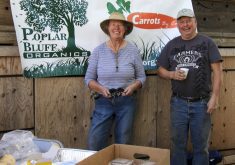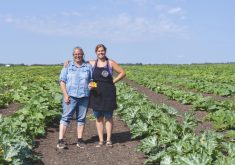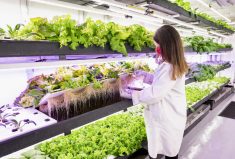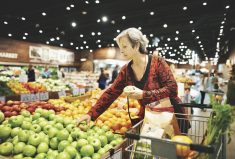Trissia Mellor is on a mission to boost the sustainability of farmers and small businesses in eastern Ontario. In Northumberland County’s economic development and tourism department, she’s the energetic agriculture manager, and she’s also heavily involved in getting the new Ontario Agri-Food Venture Centre (OAFVC) up and running.
The venture centre is one of a growing number of regional food hubs in Canada that is using consumers’ appetite for local food to benefit local farmers, small businesses and rural communities.
“We are helping farmers find ways to grow their business without putting them at a disadvantage,” Mellor says of the centre’s work.
Read Also

Riding the tariff rollercoaster
Farmers are accustomed to roller-coaster years. But the current geopolitical windstorm is something else entirely. On his cattle operation near…
Food hubs can be bricks-and-mortar regional warehouses where local farmers’ products are gathered and distributed to retail and institutional outlets. Or they can be digital, a sort of virtual gathering place where producers and buyers connect to make business transactions.
Obviously, there’s a lot of opportunity nearby. Some food hubs offer processing services, or they conduct business and marketing workshops for farmers. Some provide cooking classes to teach consumers how to prepare healthy local food. Some are co-operatives, some are private companies, and some others are publicly owned.
They’re also a hot trend. A survey of national food hubs in 2013 conducted by Michigan State University and the Wallace Centre at Winrock International found that 61 per cent of the 222 U.S. hubs they studied were less than five years old.
While there are many different kinds of food hubs, the United States Department of Agriculture’s (USDA) working definition of a food hub is “a business or organization that actively manages the aggregation, distribution and marketing of source-identified food products primarily from local and regional producers to strengthen the ability to satisfy wholesale, retail and institutional demand.” It’s a mouthful, but the direction of it is clear.
The survey also showed that food hubs are generating positive cash flows whether they are old or new. Even so, the most successful hubs are the ones that have been in business for 10 years and have many farmer suppliers. About 40 per cent of hubs are privately held, and another 32 per cent are non-profits, including producer-owned co-operatives. Most of the suppliers to these food hubs are small- to medium-size producers.
The idea is catching on in Canada. Vancouver and Edmonton are among several cities that have food hubs as part of their food strategies. Just Foods is a non-profit organization whose mission is to “work towards vibrant, just and sustainable food and farming systems in the Ottawa region.” Its main motivation is increasing access to healthy local food for everyone in the area.
Ontario’s Local Organic Food Co-ops is conducting a regional food hub expansion project in four locations including Sudbury, Ottawa, Thunder Bay and London with more than $73,000 in help from the province’s Local Food Fund.
As well, Gordon Food Services (GFS), a U.S.-based food distributor, is working with the Greenbelt Fund to help develop food hubs in different areas across the province. It already has more than 600 local Ontario products in its offerings.
When asked if food hubs make farmers more money, Pete Bozzer, local food sales specialist at GFS says, “Market value will be market value. What the hub does for farmers is it allows them to minimize costs by providing one central distribution point and co-ordinated volume purchases and packaging, as well as sales and marketing.”
Three key factors that the big food distributors are looking for are food safety, traceability and consistent, standardized packaging, according to Steve Crawford, business development specialist for produce, dairy and local at GFS.
Crawford has been working on the local food file for five years and thinks there’s tremendous opportunity for local farmers to supply larger buyers, but they need to work together.
“And now’s the time to take advantage of the exchange rate — if we do a good job now as a company and with our customers, it will help us maintain markets later, when things change,” Crawford says.
His company has a deal with Woolwich Dairy to act as a food hub for artisanal cheese makers like the Thornloe Cheese Factory north of New Liskeard and the Upper Canada Cheese Company in the Niagara region. Woolwich aggregates the cheese at its factory in Orangeville and Gordon Food Service picks it up and distributes it.
Back at the Agri-Food Venture Centre, a May 1, 2015 launch by Ontario Premier Kathleen Wynne was followed quickly by equipment testing and clients lining up to use the state-of-art facilities. The centre offers services including cutting, washing, bottling, packaging, flash-freezing and labelling. It also has a laboratory for recipe development and refrigerated storage space.
The centre’s mandate is diverse, including supporting farmers seeking value-adding opportunities, helping foodies with recipe development and working with food processing startups and expansions.
The idea for the $2.4-million facility came out of a Business Retention and Expansion (BR&E) project through the Ontario agriculture ministry.
Funding for the centre itself came from a variety of sources, including the provincial and federal governments, several eastern Ontario municipalities and a local federation of agriculture.
While the centre only recently opened, the plan is to break even within the next 2-1/2 years.
“As a publicly owned, non-profit institution, we are completely open and transparent about what we are doing with the money we receive,” Mellor says. “Any profit will be reinvested back into the facility.”
Mellor says the centre offers farmers a way to add value to their products without having to break the bank. He points out that individual pieces of food-processing equipment can have prices tags of $80,000 to $100,000, and farmers would also face the costs of meeting health and safety regulations, plus the possibility of increased property taxes.
When talking to farmers, Mellor says, “we have the equipment available for you when you need it and you don’t have to pay for it when you’re not using it.”
The centre is already popular — Mellor says she gets about six calls a day from farmers and entrepreneurs — and while it’s just starting up, there’s a lot of research that shows facilities like this can boost bottom lines for farmers and everyone else in the community.

Cornell University completed a U.S. study in December 2013 that said food hubs made more local farm products available and helped farmers expand their businesses through access to better freight and storage as well as increased exposure to large urban wholesale customers. Medium-size farms did the best in terms of getting more opportunities for sales.
In terms of the effect of food hubs on the local economy, the study found a 63 per cent increase in demand for other industrial products for every additional dollar spent on food hub products.
A January 2013 USDA study on the role of food hubs in local food marketing said that farmers who supply The Local Food Hub in Charlottesville, Virginia reported an average 25 per cent increase in sales as a result of working with that hub. All 60 farmer suppliers have small- to medium-size businesses and take advantage of a large menu of services offered by the hub — from networking to insurance coverage to rental space in cold storage, discounted seeds, and inexpensive website development.
But all is not rosy on the food hub front. In the same USDA study, several drawbacks were documented, including insufficient capital, a lack of risk management planning, human resource and staffing issues, poor access to food-processing facilities, difficulty obtaining contract and food safety liability insurance, the costs and time of complying with regulations and more. Because of the alternative nature of the business models, most new food hubs can’t get financing through traditional channels and have to turn to micro-lenders, non-profit organizations or government for grants or loans.
Back in Ontario, the FoodHub pilot project was initiated by the South Central Ontario Region Economic Development Corporation (SCOR), which includes Brant, Middlesex, Oxford and Elgin counties. It has 20 to 30 producer suppliers, depending on the time of year, and customers can order products online at their website.
FoodHub has four product drop-off locations, including White Crest Mushrooms, VG Meats, Norfolk Fruit Growers and Froese Vegetables.
The FoodHub has been up and running for only a year and a half.
“We ran into some difficulties last year, so things didn’t get done, and we had limited sales,” says Kim Earls, SCOR’s regional economic development co-ordinator. “But the producers and hubs stuck with us — I’m so thankful for them.”
Since then, they’ve hired a dedicated sales and customer relations person and a food hub co-ordinator who takes care of matching up the orders on the website and arranging deliveries.
“For us, logistics is a make-or-break component of the business,” Earls says.
The FoodHub’s customers include Gordon Food Service, which uses the FoodHub to meet its 25 per cent local food target. The hub also supplies the local student nutrition program that feeds 900 schools in three counties. A major customer is MealSource, a non-profit organization that handles food contracts for 34 hospitals and other health facilities throughout Ontario. Wendy Smith, a contract specialist with MealSource, is a member of the steering committee of the FoodHub.
“Having a clear picture of who you want to sell to is a must for any food hub,” says Earls. “We were fortunate to have MealSource as an anchor customer.”
The next steps for SCOR are to continue building relationships with producers and reaching out to new customers. Eventually, the business will be turned over to the producers and hubs.
Nick Vranckx, owner of Blueberry Hill Estates in Norfolk County likes selling his products through the FoodHub because it streamlines the process of finding suppliers, because of the handy drop-off location in Simcoe and because of the $100 lifetime registration fee.
He would like to see more people signing up for the service, and has high praise for the people running the hub. Vranckx employs 100 to 150 pickers and supplies fresh blueberries to Longo’s grocery stores as well as making several products on farm, including blueberry wine and pickled blueberries.
“It’s almost too good to be true,” Vranckx says. “I know of growers who have to pay the (Ontario) Food Terminal up to 15 per cent of their sales.”
















